The Andalusian horse is the kind of horse you would imagine to be in medieval fantasy novels and movies.
The picture-perfect horse for knights and royalty. It is hard to forget such a beautiful creature with a luxurious long flowing mane and tail, powerful arched neck, noble-looking head, and compact body with beautifully animated movement.
So it is no wonder that Andalusians were owned and ridden across Europe by Spanish diplomats and Kings.
The Andalusian, a strain of the Pura Raza Española which means the Pure Spanish Horse or PRE, is from the Iberian Peninsula, where its ancestors have lived for thousands of years.
Famous as a classical dressage horse, Andalusians are so much more. They are actually very versatile in their uses and can excel in many disciplines, even jumping, western riding, trail riding, and driving horses.
Table of Contents
Breed: Andalusian Horse
Other Names: Pure Spanish Horse, Pura Raza Española
Origin: 15th Century
Place of Origin: Spain
Horse Type: Baroque Horse, Sport Horse, Riding Horse, Show Horse
Blood Type: Warmblood
Lifespan: 25 Years
Adult Height: 15.0 to 16.3 hands
Adult Weight: 900-1200 pounds
Colors: All colors, most common is grey
Physical Traits: Strongly built, compact, elegant, thick mane and tail, straight or slightly convex profile
Movement: Elevated way of going, energetic, overtrack less than some other breeds, and move with upright steps
Temperament: Noble, affectionate nature, intelligent, willing, brave, responsive
Common Uses: Dressage, show jumping, horse shows, performances, general riding, endurance
Associations and Registries:
- International Andalusian & Lusitano Horse Association www.ialha.org
- United States P.R.E. Association www.usprea.com
Andalusian’s History & Origin
Direct Descendants of the Iberian Horse – First Horse of Europe
Andalusians are a unique baroque breed that traces its roots back to the Iberian Peninsula, which comprises Spain and Portugal. They are direct descendants of the Spanish Horse, also known as the Iberian horse, which is the first horse breed of Europe.
The Iberian Horses – Andalusian and Other Similar Breeds
Andalusians are also referred to as the Pure Spanish Horse or PRE and fall under the category of Iberian horses. This group includes a few other breeds, such as the Alter Real, Lusitano, Peninsular, and Zapatero, that share similar characteristics with the Andalusian breed.
Tracing Back the Andalusian Horse – Close Relation to Lusitano
Among these Iberian horses, the Andalusian breed has a close relationship with the Lusitano breed. The Lusitano breed was named after Portugal’s previous name, Lusitania. Andalusia, which is the original province of the Andalusian breed, was originally known as Vandalusia and is located at the southernmost point of the Iberian Peninsula.
The Mysterious Origins of Andalusian Horses
The Andalusian breed is considered an ancient breed, and its origins date back to prehistoric times, with some suggesting it may even predate the ice age. The exact creation and development of the Andalusian breed remain shrouded in mystery, with several theories proposed.
Theories Surrounding the Creation of Andalusian Horses
One theory proposes that Iberian horses were cross-bred with horses brought to the peninsula by explorers, leading to the creation of the Andalusian horse in the 1400s. Another theory suggests that Andalusians were the result of crossing Barb and Arab horses brought by the Moors during the eighth century with the Spanish Horse. However, it has been said that the Andalusian origins are not entirely based on Arab blood.
Descendants of 2000 Numidian Mares
Another theory suggests that Andalusians are descendants of the 2000 Numidian Mares, which were shipped to Spain by the Carthaginian general Hasdrubal. Despite these theories, the true origins of the Andalusian horse remain a mystery.
Andalusian Horses – Famed War Horses and Riding Mounts
Andalusians became famous as great war horses, taking on the legacy of the Iberian horse. They were favored for their speed and agility, which made them popular among European royalty. As horse riding grew in popularity, riding academies began to form, and the Andalusian breed became a popular mount.
Despite the many theories about its origins, one thing is for sure – the Andalusian horse is an ancient breed that has stood the test of time and remains a beloved breed to this day.
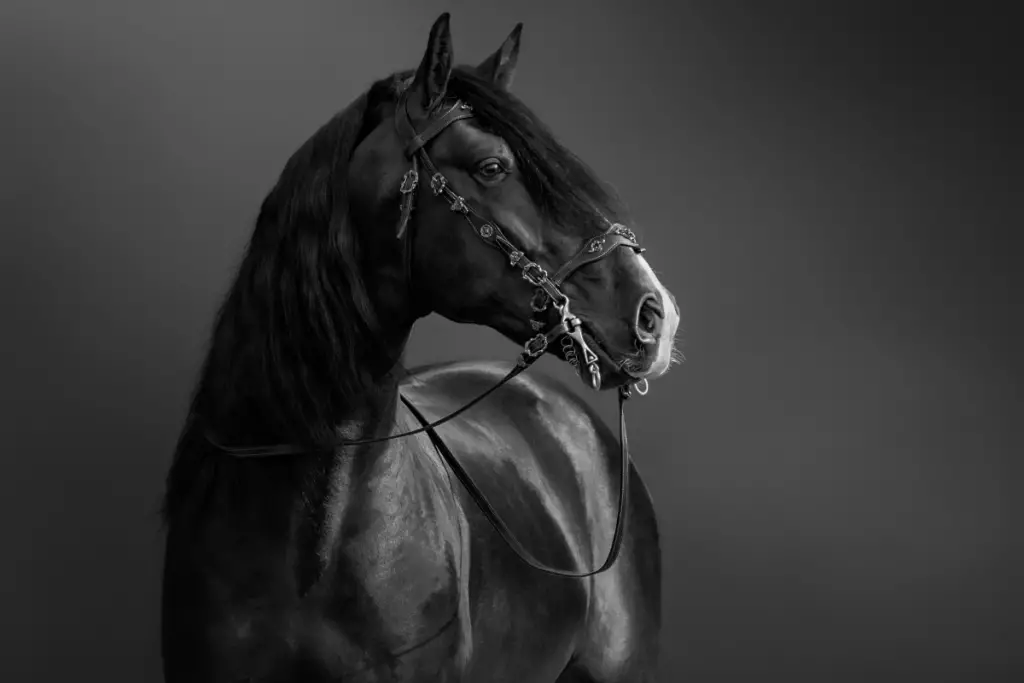
Breeding
Since the 15th century, the breeding of Andalusians has been centered around Jerez de la Frontera, Cordoba, and Seville in Spain where it was preserved by Carthusian monasteries. These Andalusians are known as the Carthusian Andalusians.
There are 2 types of Andauliasians if you can believe it. One is more heavily built, more robust limbs than the average light-riding horse and the other type has a lighter build more typical of the light-riding horse.
The Andalusian breed has had a great influence on many other European horse breeds and has been a foundation for most American breeds. Some of these breeds are the Holstein, Oldenburg, Friesian, Lipizzaner, Kladruper, Frederiksberg, the Old Norman Horse, The Hackney, the Orlov, and in America, the Quarter Horse, and Criollo.
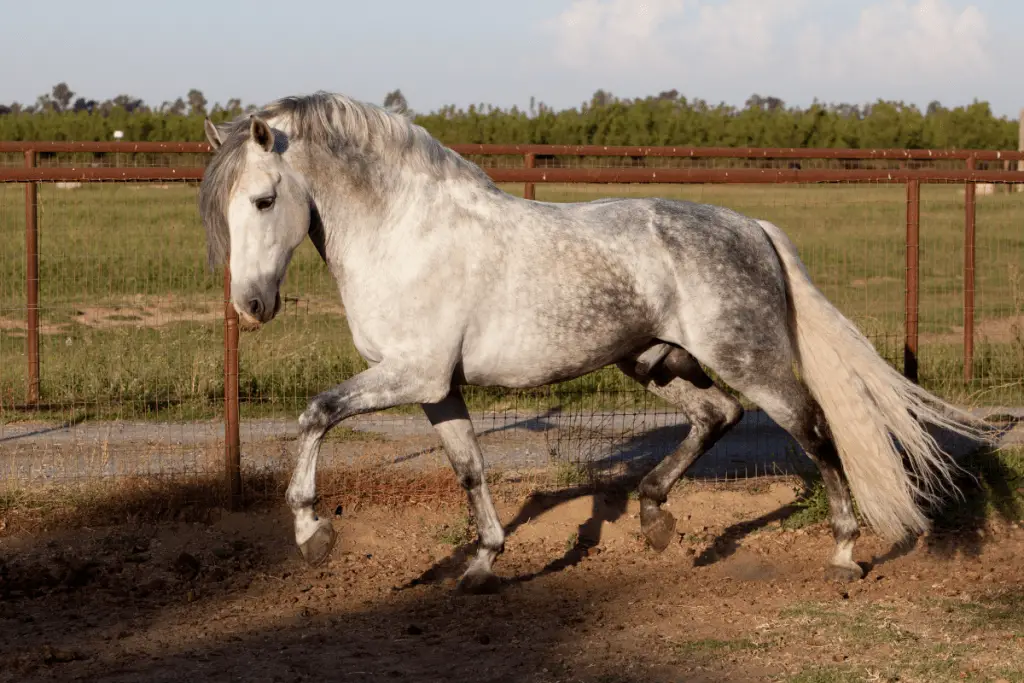
Unique Characteristics of The Andalusian Horse
Appearance of Andalusian Horses
Andalusian horses are renowned for their striking physical appearance. Their well-proportioned head features big, kind eyes, a broad forehead, and a hawk-like profile that can either be straight or slightly convex. Their necks are short, thick, and elegantly arched, setting on broad, strong shoulders. The Andalusian’s chest is deep and broad, while their barrel is round. Their hind end is well-muscled and set on a short, compact back. The tail, low-set on the hindquarters, is thick and flowing, as are their manes and forelocks. Andalusians are also known for their hardy, well-formed hooves.
Movement and Gait of Andalusian Horses
The Andalusian horse is famous for its animated, elegant gait. Although they don’t overstep with their hind legs as much as other breeds, Andalusians have exceptional flexion in their joints, resulting in smooth and flowing movement. They are incredibly agile and nimble, which makes them ideal for a wide range of activities.
Trainability and Intelligence of Andalusian Horses
Andalusians are known for their high level of intelligence, making them easy to train and quick to learn. They are versatile and excel in various disciplines, including dressage, show jumping, and driving, among others. Their intelligence also makes them great for leisure riding and working on the ranch.
Size Of The Andalusian Horse
The Andalusian horse is a majestic breed that has been revered for its strength, beauty, and versatility. If you’re interested in owning one, it’s essential to understand the size of the Andalusian horse. In this article, we’ll discuss the average height, weight, and registration requirements for this impressive equine.
Average Height and Weight of Andalusian Horses
Andalusians are typically strong and compact horses that stand between 15 and 16 hands tall, with an average height of 15.2 hands. These horses weigh between 1,000 to 1,300 pounds, with stallions and geldings tending to be heavier than mares of the same height.
Registration Requirements for Andalusian Horses
The Association for Purebred Spanish Horse Breeds of Spain has set minimum height requirements for Andalusians to be eligible for registration. Mares must be at least 14.3 hands, while geldings and stallions must be at least 15 hands tall.
In addition to meeting the minimum height requirements for registration, horses can also be approved as elite stock, which has different height requirements. An elite mare must be at least 15 ¼ hands tall, while a gelding or stallion must be 15.1 hands or taller.
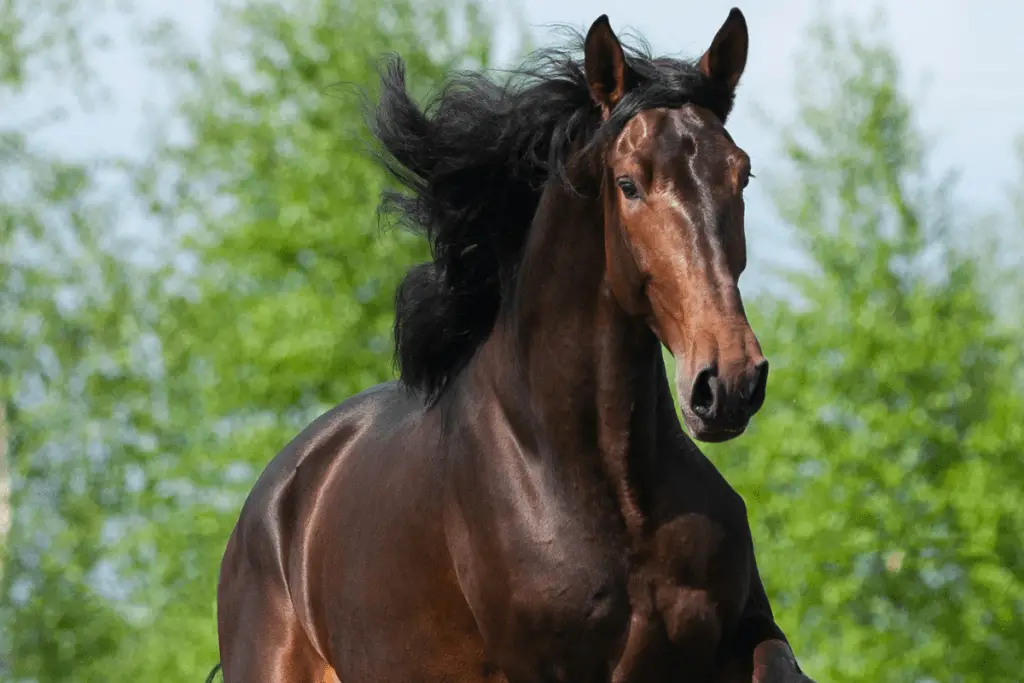
Colors & Markings
The Evolution of Coat Colors in Andalusian Horses
In the past, Andalusian horses were known for their wide range of coat colors, including spotted patterns. However, over time, the breed has been refined, and most Andalusians are now found in shades of gray or bay. This is due to selective breeding practices, where breeders have focused on specific coat colors and patterns.
The Current Status of Andalusian Horse Coat Colors in the US
In the US, over 80% of all Andalusians have a gray coat, with approximately 15% having a bay coat and the remaining 5% sporting black, dun, palomino, or chestnut coats. While other colors such as buckskin, pearl, and cremello are recognized by registries, they are rare to see.
Uncommon Coat Colors
Buckskin and cremello coats are particularly uncommon in Andalusian horses, with black, chestnut, dun, roan, and palomino coats being relatively more common. This can be attributed to the fact that breeders tend to focus on certain colors and patterns, making it less likely for other colors to appear.
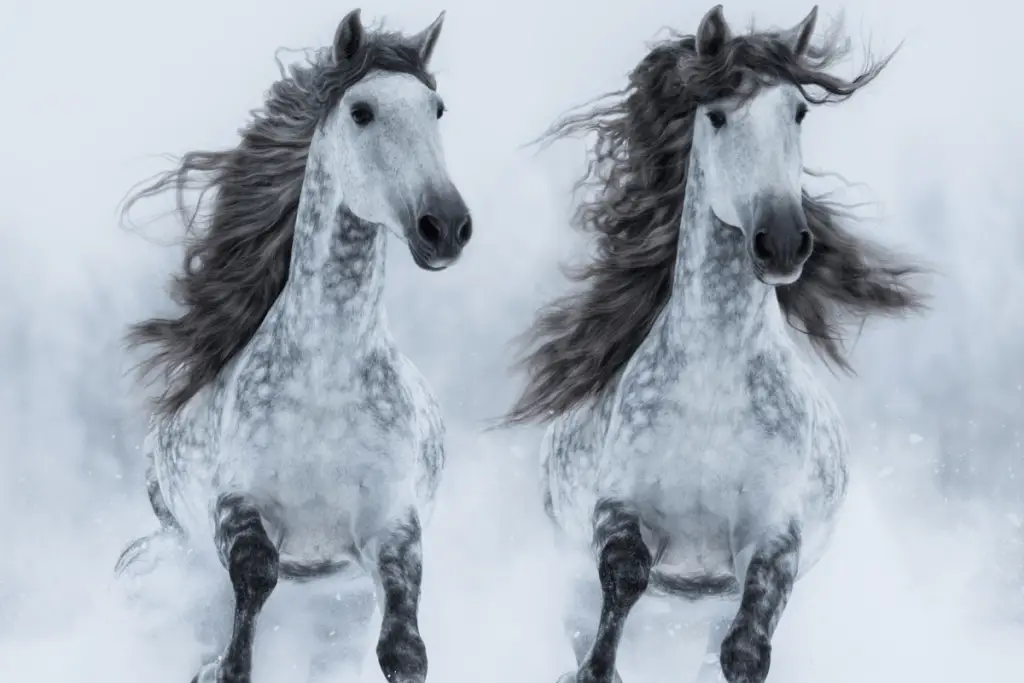
Temperament
These horses were primarily used in warfare due to their strength, agility, and bravery. Through centuries of selective breeding, the Andalusian horse has developed a temperament that blends pride and dignity with calmness and gentleness.
Docile and Intelligent Nature
The Andalusian horse’s docile and intelligent nature has made it a popular choice for riders of all levels. Their obedient disposition and strong desire to learn make them easy to train, and they are highly adaptable to different situations. However, their spirited nature and quickness require a more experienced rider to handle them properly.
Riding Andalusian Horses
People love riding Andalusian horses because they are kind and intelligent. They are also quick learners, making them easy to train for various activities such as dressage, jumping, and pleasure riding. The breed’s temperament also makes them suitable for children to exhibit stallions, except in certain classes, according to the United States Equestrian Federation.
Uses
The Andalusian’s Remarkable Qualities
Andalusians are a breed of horse that possess a wide array of abilities and talents that have made them well-known and admired throughout the world. With their bravery, energy, and agility, they have become a favorite among equestrians in different fields. Their remarkable ability to maneuver and turn quickly in bullfighting has made them a valuable asset in the ring. However, some people view bullfighting as a cruel sport, and there are other areas where Andalusians excel.
Andalusians in Parades and Circuses
Apart from bullfighting, Andalusians are also commonly seen in parades, where their high-stepping gaits and noble presence make them a sight to behold. Their beauty, energy, and trainability have also made them an excellent addition to circuses, where they showcase their impressive skills.
Andalusians in Dressage and Other Disciplines
Andalusians are light riding horses that excel in dressage, having been among the first horses used in classical dressage. Their impulsion in all gaits and elevated leg action make them particularly suited to the upper-level movements of high school dressage. Furthermore, Andalusians are versatile horses that do well in a variety of disciplines, including western and English riding, trail riding, jumping, driving, and working cattle.
The Enduring Popularity of Andalusian Horses
Overall, Andalusian horses are a breed with a wide range of uses, from bullfighting and parades to circuses and dressage. Their discernible cadence and impulsion in all gaits, as well as their impressive speed of up to 55 mph, make them a remarkable breed that continues to capture the hearts of horse enthusiasts worldwide.
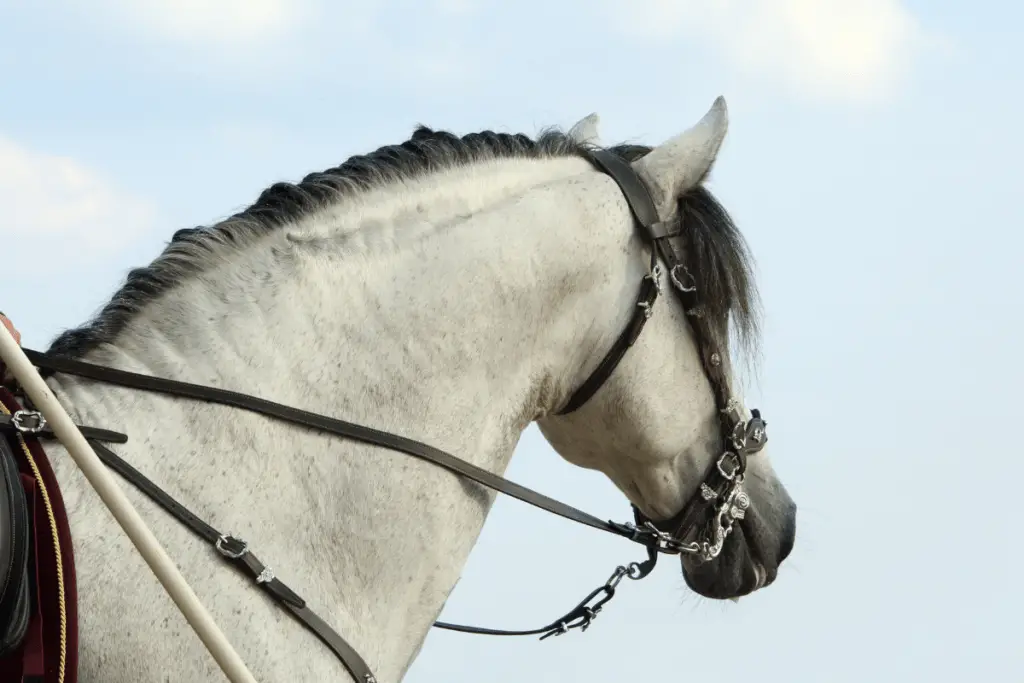
Diet & Nutrition
Andalusian horses are known for their easy-keeping tendencies, which can make them susceptible to metabolic issues if not managed properly. As a responsible horse owner, it’s important for you to provide them with a diet that maintains their weight while still providing proper nutrition.
The Importance of a Proper Diet
Andalusians require a diet that is rich in nutrients but also helps them maintain a healthy weight. Quality hay and minimal grain, along with a vitamin supplement or ration balancer, can be a great foundation for their diet. It’s important to ensure that the hay is of high quality to provide them with the necessary nutrients.
Managing Grazing on Lush Grass
Overgrazing on lush grass can cause metabolic issues in easy keepers. Therefore, it’s important to restrict their grazing time on grass and monitor their intake. Using a grazing muzzle or limiting their time on grass can help prevent overeating and maintain their weight.
Supplementing Nutritional Needs
In addition to hay and minimal grain, Andalusians may require additional supplements to fulfill their nutritional requirements. It’s important to consult with a veterinarian or equine nutritionist to determine what supplements are needed for your horse based on their specific needs.
By managing their diet and grazing habits, Andalusians can maintain optimal weight and nutrition, reducing the risk of metabolic issues. As a horse owner, it’s important to stay vigilant and monitor their diet and exercise habits to ensure their overall health and well-being.
Health Issues Common in Andalusian Horses
Andalusian horses are prone to several health issues, which include:
- Metabolic Issues: Being overweight or aging can lead to metabolic issues in Andalusian horses. These issues can result in metabolic disorders such as Equine Metabolic Syndrome (EMS).
- Laminitis: Intestinal issues are usually associated with laminitis, which is a common health issue in Andalusians. It is a painful condition that affects the horse’s hooves and can be fatal if left untreated.
- Small Intestine Issues: Due to reduced blood flow in the small intestines, Andalusians are more prone to developing small intestine issues. This can result in colic, which is a severe abdominal pain that requires immediate medical attention.
- Melanomas: Grey Andalusian horses are more likely to develop melanomas, which are tumors that can be benign or malignant. Melanomas can occur anywhere on the horse’s body and can be life-threatening if left untreated.
Proper Grooming for Andalusian Horses
Andalusians, like any other horse breed, require regular grooming to maintain their health and beauty. Regular grooming not only helps to keep the horse looking its best, but it also helps to build a bond between the horse and its owner.
We’ll explore the proper way to groom an Andalusian horse, including tips for maintaining a grey coat and how to manage the thick and wavy mane and tail.
Regular Grooming for Andalusian Horses
To keep an Andalusian horse in good condition, regular grooming is essential. Grooming helps to remove dirt and sweat from the horse’s coat, which can lead to skin irritations if left unattended. It also helps to distribute the horse’s natural oils throughout the coat, giving it a healthy shine. A good grooming routine should include the following:
- Currying: Currying is the act of brushing the horse’s coat in a circular motion to remove dirt and dead skin cells. It also helps to bring out the natural oils in the coat, giving it a healthy shine.
- Brushing: After currying, use a stiff-bristled brush to remove any remaining dirt or debris from the coat. Pay close attention to areas like the legs, underbelly, and mane, where dirt can accumulate.
- Bathing: Bathing an Andalusian horse should be done only when necessary, as too much bathing can strip the coat of its natural oils. If you have a grey horse, be prepared to give more regular baths or spot clean more often than a bay or darker-colored horse.
Maintaining a Grey Coat
Grey Andalusians require special care to keep their coat looking clean and bright. Grey horses are more prone to staining than other colors, and their coats can quickly become discolored if not properly maintained. To keep a grey Andalusian looking its best, follow these tips:
- Regular Baths: Grey horses will need more regular baths than other colors to keep their coat looking clean and bright. Be sure to use a gentle shampoo that won’t strip the coat of its natural oils.
- Spot Cleaning: If you don’t want to give your horse a full bath, spot cleaning is a good option. Use a damp cloth or sponge to clean any stains or dirt from the coat. Be sure to rinse the area thoroughly and let it dry completely before grooming.
Mane and Tail Care
One of the most tedious grooming tasks with an Andalusian horse is maintaining the mane and tail. Andalusians are known for their long, thick manes and tails, which require regular care to keep them healthy and beautiful. Here are some tips for maintaining an Andalusian’s mane and tail:
- Detangling: Use a wide-toothed comb to detangle the hair, starting from the ends and working your way up to the roots. Be gentle, as the hair can be easily damaged.
- Conditioning: After detangling, use a leave-in conditioner to keep the hair soft and prevent tangling.
- Braiding: If your horse has a long mane or tail, consider braiding it to prevent tangling and breakage. This is especially important for horses that are turned out in a pasture or stall with other horses.
Famous Andalusian Horses
There are famous Andalusian horses in history as well as featured in films as well.
The most famous Andalusian in history is Babieca. Rodrigo Diaz de Bivar is also known as El Cid Campeador was the rider of the magnificent white stallion Babieca. He was a respectable warhorse that rode valiantly in the battle for 30 years always to victory.
Films using Andalusian horses as part of the cast include:
- Gladiator
- Interview with the Vampire
- Lara Croft Tomb Raider: The Cradle of Life
- Braveheart.
- The Lord of the Rings film trilogy
- King Arthur
- The Chronicles of Narnia: The Lion, the Witch and the Wardrobe
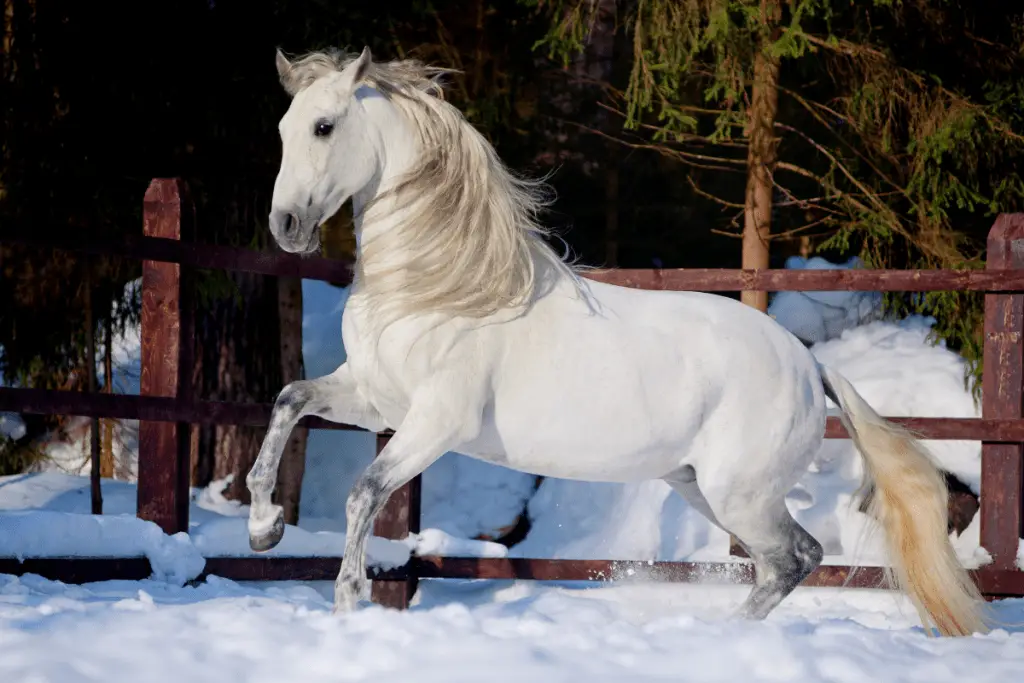
Is The Andalusian The Right Horse For You?
If you are looking for a beautiful striking horse that will grab attention then an Andalusian might be right for you. However beauty aside, Andalusians are forward, sensitive and spirited so they are best suited for riders at an intermediate level or higher.
If you are an experienced rider and you want an intelligent, quick-learning horse, an Andalusian could be the right choice. Just remember they learn easy and quick which can mean you can teach them bad responses by accident as easily as good ones.
Andalusians naturally want to collect and with their beautiful animated movement, they make great dressage horses.
Andalusians are not a good choice for riders on a budget. Expect to pay at least $10,000 for a trained, registered Andalusian. And that would be limited horses to look at. These horses can go for much much higher double, triple or more.
Pros
- Flashy movement
- Athletic and versatile
- Willing, easy to train, and intelligent
- Docile temperament
- Easy keeper
Cons
- More expensive than most breeds
- Sensitivity and forward gaits not suitable for beginner
- Prone to laminitis and metabolic issues such as Cushings
How To Adopt Or Buy An Andalusian Horse?
Andalusians are horses of high value, so they are not often seen available for adoption at horse rescues. Possibly a cross with Andalusian may be available at a rescue.
Options for buying an Andalusian include:
- A breeding farm that breeds and sells Andalusians.
- A competition barn that sells Andalusians with a show record.
- You may also find a private seller through an online classified site.
No matter where you find an Andalusian to adopt or purchase, it is important to make sure the horse is specifically the right match for you. As well as do a pre-purchase exam to determine if the horse is sound and will hold up to what type of riding you want to do with the horse.
Andalusian Horse Associations
- International Andalusian & Lusitano Horse Association
- United States P.R.E. Association
- The Foundation for the Pure Spanish Horse
- Australasia Andalusian Association
- National Association of Purebred Spanish Horse Breeders of Spain
Cheers, Kacey

